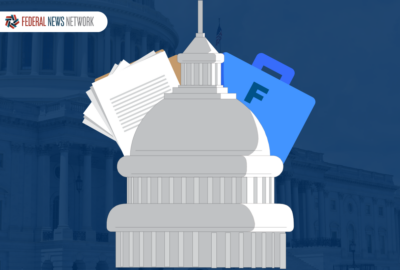The Government Publishing Office takes steps to preserve print
"Our libraries all have preservation programs to varying degrees," the GPO's superintendent of documents, Scott Matheson, said.
We might live in a digital era. But many Americans still like to read things in print — ink on paper. Now, the Government Publishing Office has expanded relationships with four university libraries to preserve federal printed materials and ensure public access. For details, the Federal Drive with Tom Temin turned to the GPO’s superintendent of documents, Scott Matheson.
Interview transcript:
Tom Temin Mr. Matheson, good to have you with us.
Scott Matheson Glad to be here, Tom. Thanks for having us.
Tom Temin And this comes under something called the Preservation Stewardship Program. Maybe let’s start with an outline of the extent of that program, how many libraries participate and what they actually do.
Scott Matheson Sure. Preservation stewards is one of our forms of partnerships. It’s one of the most popular. We’ve got about a little over 85 partnerships and counting. Preservation stewards is about 50 libraries. So that’s a big chunk of our partnership program. And it really is a way for us to make sure that we are taking care of the national collection of U.S. government public information that we have distributed for hundreds of years, GPO for over 100 years, to our library partners around the country. This is a way for us to make sure that that is preserved and remains available in multiple formats. It’s one of our preservation strategies.
Tom Temin And what are some of the things that are still printed for preservation?
Scott Matheson We still print a great deal. As you know, congressional documents are key, as we’re a large branch agency. But we also print the United States reports, which is the reports of the Supreme Court of the U.S. and we print the statutes at large for the National Archives. That is, the chronological arrangement of our laws. Some of the things that our new preservation stewards are preserving include the public papers of the U.S. president, which was a long running publication of documents related to the presidency and a great research resource. We also have somebody a new library has picked up some historic U.S. Forest Service publications. Those are particularly useful for our research community when they want to know sort of what the science was at various times through our history.
Tom Temin So these libraries actually have physical copies that they have on a shelf that the public can access.
Scott Matheson They do. That part of the program is libraries. Look around at what they have in their collection that we have sent them over the years as part of the Federal Depository Library Program. They decide what’s important to their community, and then they commit to inventorying it, doing a condition assessment, making sure that everything is in good shape, and then they market as a preservation steward copy and they keep good records. And there we’re really concerned that they communicate with us fairly frequently to make sure that we know that as personnel change on both sides, that everybody is aware of the partnership and aware of the commitments that we’ve made to each other to retain these documents and make sure that they’re accessible to the library’s community.
Tom Temin All right. And most recently, I guess in the last couple weeks or so, the GPO has expanded this partnership and maybe signed up a couple of new libraries. Tell us what’s going on right now.
Scott Matheson Absolutely. We’re in the midst of a big recruitment effort among our depositories. And these four libraries you referred to are definitely part of that. The Louisiana State University’s Law Library and the Lakes Library at the Colorado School of Mines are longtime stewards who have added new titles, new sets of books that they want to preserve to their agreements with us. And Colgate University’s Case Library and the University of Idaho Library, our new preservation stewards. That is, they’re long time depository libraries, but they’ve come in to this program, this partnership with us, to preserve new documents. I just want to call out, among those four libraries, Louisiana, Colorado, New York and Idaho, you see the geographic distribution. That’s a big part of our strategy to keep these preserved titles spread out around the country and make sure that there are copies close to the folks who want to use them. These libraries also can, of course, share among themselves. So if somebody comes to a different library, perhaps in eastern Washington, they may be able to get copies of the materials they need from, for example, the University of Idaho, that facilitates even broader access.
Tom Temin And what is incumbent on the libraries with respect to preserving them, because they are delicate in some ways? Paper doesn’t take care of itself.
Scott Matheson Absolutely. Our libraries all have preservation programs to varying degrees. Large research libraries have very robust programs, but even smaller local public libraries will have somebody who’s in charge of making sure the books are in good shape, or repairing them or replacing them if they’re not. A big part of our program involves what’s called a condition assessment. When the library first comes in, they go through every copy of the book in that set. For example, if you’re preserving the U.S. reports, you want to look at every volume of the hundreds of volumes of those and see what kind of shape the paper is in, see what kind of shape the binding of the book is in, and how all of that is holding together. We have a checklist that folks can use to do that condition assessment. The condition ranking has to be good or better for them to be a preservation copy. And if it’s not, we obviously can then work in our network to provide a better condition, copy the libraries then are charged with making sure that they keep those up to date. They report any damage or any loss to their materials. Some libraries store these in closed stacks or off site, and some libraries store them in their open stacks where people can use them easily, but they keep an eye to make sure that they’re remaining in good condition.
Tom Temin No pizza eating and grabbing the books. We’re speaking with Scott Matheson. He’s superintendent of documents at the Government Publishing Office. And by the way, if one gets damaged of a book and maybe it’s old and there aren’t a bunch of copies, do you have a provision for either the GPO itself with your craftsmen or maybe somebody local, because books can be renewed and rebound and so on?
Scott Matheson Absolutely. We’ve done a few pilot projects that involve some of these more rare collections, and one of the things that we’ve found is that sometimes libraries could use some help with what is called conservation, and that is what you refer to, sort of rehabbing a book. The other thing our policy allows us to do is if we have a high quality scan in our preservation repository, we are, by policy, allowed to create a new print copy of that book and replace the damaged copy in the library. That’s not something that we’ve done a lot of to this point, but it is something that we anticipate may at some point be something that’s needed.
Tom Temin Yeah. That shows the advances in printing technology. You can make really credible book quality types of copies in low volume that doesn’t look like a Xerox type of situation, but it’s also not 10,000 copies.
Scott Matheson Right. Absolutely. Our plant is constantly looking at these new technologies for doing these very short run web to press type publications, and it’s certainly something that we have in our list of options for replacing some of these materials. We, of course, love the beautifully hand bound, stitched hard, you know, case bound hardcover books. And those are particularly good for library use because they stand up very well. But even our perfect bound books really gotten they’ve gotten so much better at the last 10 or 15 years since I started looking at that. They hold together better now.
Tom Temin Yeah, it’s hard to tell.
Scott Matheson It’s definitely an option.
Tom Temin With authors, you can’t tell what’s a vanity book and what’s actually somebody was paid to publish these days. Does GPO keep metrics on what is accessed and what people are reading?
Scott Matheson We keep metrics on how many people have access to our GovInfo repository, where our electronic copies of both new publications and our historic converted publications live. We are in the process of examining how libraries keep statistics. That is, something in the library world is a bit up in the air at the moment, as libraries have shifted more to online, keeping track of the print usage has become more complicated and a little more difficult. So we are looking at that, but we don’t have a unified way of knowing who’s using these materials across our 1,100 libraries. We can ask specific libraries and sometimes they have information, but it’s not a not a metric we have at the moment. Definitely something we’re interested in, because we get that question all the time. Who’s using this or how often does it get used?
Tom Temin Fair to say, that little card in the back of a book that went into a little slipcase with all the people, that’s long gone, isn’t it?
Scott Matheson We don’t have those anymore. And our libraries take patron privacy really seriously, so they often don’t even keep records once the book is returned of who even checked it out, or certainly who was using it in the library. So definitely not a thing. We can count lines like I used to be able to do when I was in elementary school, count the lines on the on the checkout card.
Tom Temin Or find out the last person that took it out was in 1917 or something like that. And just a question about the papers of the presidents. These are in bound books. Are these are the same things that administrations send to NARA at the close of the administration, or is it a subset of all of that?
Scott Matheson It’s a subset of that. It’s a set that began in the mid-20th century and in fact closed out with the end of an era, has ceased to publish it. They’re the publishing agency. They closed the set off at the end of the Obama administration. So when that last volume is published, it is a selection of materials produced by the Office of the Press Secretary and the Executive Office President. There are often photo folios, sets of plates in the center of those books, which are great sort of ways to see the highlights of a presidential administration. And they’re really sort of the first stop for a lot of high school or undergraduate level researchers looking into what happened during a president’s administration or finding key documents from that administration. We have a larger set of materials called the Daily Compilation of Presidential Documents, the Compilation of Presidential Documents, which is on GovInfo now, and that is a little more fulsome. But because of that, it’s a little bit more difficult to wean it down to just the most interesting documents. But it is there and it’s something that we preserve. And that does continue as in there a publication, that online publication.
Tom Temin And by the way, what’s the overall strategy, just briefly, in ensuring that those things in GovInfo, the digital formats, will also exist in perpetuity? I mean, paper, you know, can last a thousand years, but a digital document might be unreadable, you know, in five years or 20 years.
Scott Matheson This is a real subject of study in information science and in librarianship, in archives work. We have several high level professionals who work to make sure that our ISO certified repository does, in fact, continue to retain that certification. And we’re one of two in the world right now that maintain that certification. We have an additional certification called Core Trust Seal. And that is where, more of a peer based evaluation. Other people who run repositories look, so we have a lot of outside folks and specific metrics that we meet for this preservation task. It’s not cheap, but it is something we take very seriously. And that is our commitment to the community and to the publications that we steward so that they are available and they will remain available going forward.
Tom Temin Scott Matheson is superintendent of documents at the Government Publishing Office. Thanks so much for joining me.
Scott Matheson My pleasure. Thank you.
Tom Temin And we’ll post this interview along with a link to more information at federalnewsnetwork.com/federaldrive. Take the Federal Drive with you. Subscribe wherever you get your podcasts.
Copyright © 2025 Federal News Network. All rights reserved. This website is not intended for users located within the European Economic Area.
Tom Temin is host of the Federal Drive and has been providing insight on federal technology and management issues for more than 30 years.
Follow @tteminWFED






